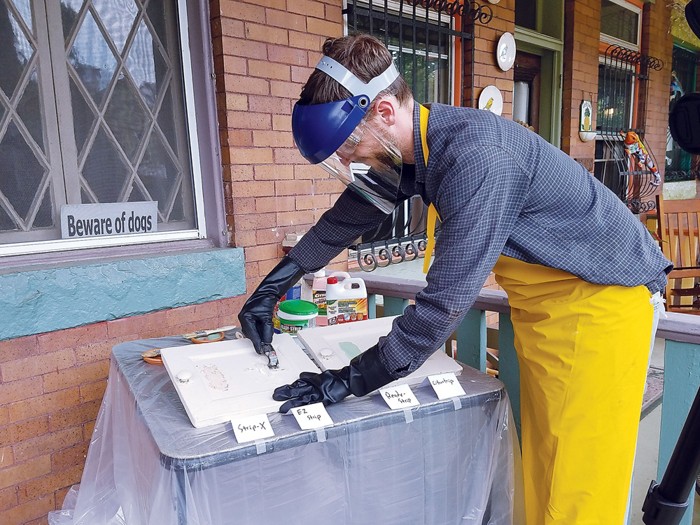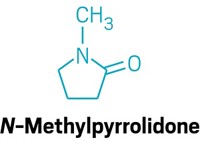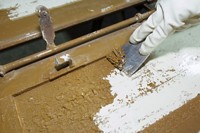Advertisement
Grab your lab coat. Let's get started
Welcome!
Welcome!
Create an account below to get 6 C&EN articles per month, receive newsletters and more - all free.
It seems this is your first time logging in online. Please enter the following information to continue.
As an ACS member you automatically get access to this site. All we need is few more details to create your reading experience.
Not you? Sign in with a different account.
Not you? Sign in with a different account.
ERROR 1
ERROR 1
ERROR 2
ERROR 2
ERROR 2
ERROR 2
ERROR 2
Password and Confirm password must match.
If you have an ACS member number, please enter it here so we can link this account to your membership. (optional)
ERROR 2
ACS values your privacy. By submitting your information, you are gaining access to C&EN and subscribing to our weekly newsletter. We use the information you provide to make your reading experience better, and we will never sell your data to third party members.
Consumer Safety
Replacing methylene chloride in paint strippers
Questions remain about the safety and effectiveness of alternative solvents
by Britt E. Erickson
June 11, 2018
| A version of this story appeared in
Volume 96, Issue 24

In early May, three mothers traveled to Washington, D.C., to urge members of Congress and the U.S. Environmental Protection Agency to ban the use of methylene chloride in paint and coating removers. Each of the women had a son who died from exposure to methylene chloride in paint-stripping products purchased at home improvement stores.
After meeting with the families, EPA Administrator Scott Pruitt said the agency will finalize a rule to limit commercial sales of methylene chloride soon. But what exactly that means and when it will happen is anyone’s guess. If EPA does ban the use of methylene chloride in paint removers, then what alternatives are available to consumers? C&EN visited several home improvement stores to find out and test how well some of the alternatives perform. We also talked with experts about new formulations currently under development.
A ban of some uses of methylene chloride-based paint removers is likely. In 2014, EPA reported that workers exposed to such products have an increased risk of cancer, as well as neurological and liver problems. At the time, EPA also concluded that consumers who use methylene chloride-based strippers face an increased risk of short-term neurological effects.
EPA is likely to ban methylene chloride, CH2Cl2, in consumer paint strippers. See how products made with and without it perform on cabinet doors with many layers of assorted paint types.
EPA proposed a ban on methylene chloride in paint and coating removal products during the final days of the Obama administration in early 2017. The Obama-era proposal would have banned both methylene chloride, also called dichloromethane, and N-methyl-2-pyrrolidone (NMP), a chemical widely used as an alternative to methylene chloride, in paint strippers. EPA declared in 2015 that NMP poses reproductive risks to pregnant women and women of childbearing age. But late last year the agency put bans of both chemicals on hold.
EPA’s recent announcement that it is moving forward with a methylene chloride rule doesn’t indicate whether the agency will also finalize the ban on NMP in paint strippers.
That leaves consumers wondering about their alternatives. Other than methylene chloride-based formulations, which are typically mixed with about 20% methanol, U.S. consumers can currently find paint removers that contain a mixture of NMP and benzyl alcohol, or NMP and dibasic esters such as dimethyl adipate or dimethyl glutarate. Stripping products are also available without NMP. Those products typically contain mixtures of dibasic esters and can include benzyl alcohol.
C&EN tested a few products on old wooden cabinet doors covered with multiple layers of paint, including lead-based paint, to find out how well the alternatives to methylene chloride perform. Each product was allowed to react with the paint for 30 minutes. A methylene chloride-based formulation was the only one that exposed any wood on the cabinet door, but it left a layer of lead-based paint behind. Mixtures of dibasic esters, both with and without NMP, removed several layers of paint but not as many as the methylene chloride-based product. A mixture of NMP and benzyl alcohol did not remove the top layer of paint within 30 minutes, although the product label recommended a longer reaction time.
Advertisement
This simple experiment confirms what experts are telling C&EN. “Paint removers with methylene chloride work really well, in 20 minutes or less, for most multilayer applications,” says Greg Morose, research manager of the Toxics Use Reduction Institute (TURI) at the University of Massachusetts, Lowell. Alternative paint removers that don’t contain methylene chloride, such as those with NMP, dibasic esters, and benzyl alcohol, “work much, much less effectively for multilayer applications,” Morose notes. It takes six to 12 hours for those products to work, he says.
Morose is managing a project at TURI that aims to commercialize alternative products that perform as well as methylene chloride-based strippers without the safety risks. The team has developed two formulations that Morose says perform as well as methylene chloride as a general-purpose paint stripper. The formulations contain methyl acetate, dimethyl sulfoxide (DMSO), and either thiophene or 1,3-dioxolane.
Although the formulations are not yet commercially available, Morose says the team is in discussions with several manufacturers. They filed a patent application for the technology in 2016.
“The university can’t produce this on its own. We need industry partners that manufacture paint strippers to take this to market,” Morose says. He is optimistic that the formulations will be commercialized soon. Manufacturers are testing the products in their own labs and are confirming they are equivalent to methylene chloride-based strippers, he says.
To be effective at stripping multiple layers of paint, products need to be able to dissolve a wide variety of polymers. “Paint coatings are just different types of polymers,” Morose explains. Three intermolecular forces control a solvent’s ability to dissolve polymers—dispersion (van der Waals), polarity (dipole moment), and hydrogen bonding. A solvent’s so-called Hansen solubility parameter takes into account all three forces.
“We did a lot of testing to find out the optimal Hansen solubility parameters” to dissolve multiple layers of paint and coatings, Morose says. “If you took any one of the solvents and tried to use it to remove paint, it would be ineffective because the Hansen solubility parameter is not optimized,” he notes. But if you combine solvents in a certain ratio, you can get a more desirable Hansen solubility parameter, he says.
The performance of paint strippers also depends on the ability of the solvents to penetrate through multiple layers. If you can get the solvent down to the substrate, all the layers are removed at once, Morose says. Alternatives to methylene chloride in paint strippers, such as NMP, benzyl alcohol, and dibasic esters, all have large molecular volumes that prevent them from getting through multiple layers, he notes. Those products work one layer at a time. That is why it takes them so long, he says.
Other experts say they would like to see more testing of the formulations developed by TURI. “It is hard to know whether they are effective,” says Katy Wolf, director of the Institute for Research & Technical Assistance, which promotes alternatives to toxic solvents. Wolf also worries about the toxicity of DMSO, which is known to mobilize other chemicals, allowing them to go through skin. The toxicity of thiophene is unknown, she adds.
For most applications, you don’t need a chemical-based paint stripper, Wolf says. Other technologies, such as abrasion, laser stripping, heat treatment, and dry ice paired with crushed recycled glass blasting, can be effective for removing paint from many surfaces, including aircraft panels and boat hulls, she says. Removing paint from wood surfaces, particularly antique furniture, however, is more challenging because you can’t use abrasion, she acknowledges. Wolf recommends using a benzyl alcohol-based stripper for such applications. It takes longer than methylene chloride, but it is less toxic and noncarcinogenic, she notes.
EPA is expected to soon finalize its rule regarding methylene chloride in paint-removing products. It is unclear, however, what will be in that final rule. Small businesses that refinish furniture are likely to be exempt from the rule, as is the Department of Defense.
In the meantime, consumer advocacy and environmental groups are pushing retailers to stop selling paint-removal products that contain methylene chloride. That pressure appears to be working. In late May, home improvement retailer Lowe’s announced it would stop selling paint strippers with methylene chloride and NMP by the end of the year.
“We care deeply about the health and safety of our customers, and great progress is being made in the development of safer and more effective alternatives,” said Mike McDermott, Lowe’s chief customer officer. “As a home improvement leader, we recognize the need for viable paint removal products and remain committed to working closely with suppliers to further innovate in this category.”
The Green Chemistry & Commerce Council (GC3), a coalition of stakeholders that aims to commercialize green chemistry approaches and more sustainable options, welcomes the opportunity to work with Lowe’s and other members on alternatives to methylene chloride in paint strippers.
“Lowe’s announcement provides an important stimulus for green chemistry solutions,” GC3 Director Joel Tickner says.
Environmentalists are encouraged by EPA’s plan to finalize the methylene chloride rule, but they remain skeptical that the agency will follow through with a ban.
At least four people have died from exposure to methylene chloride in paint strippers since January 2017, when EPA proposed to ban such products, according to the Natural Resources Defense Council, an environmental group. “Lowe’s is showing leadership as the first major U.S. retailer to eliminate methylene chloride paint strippers from its stores,” Sujatha Jahagirdar, a policy specialist at NRDC, said in a press release. “It underscores the failure of this EPA to do its job to protect the American public from dangerous toxic chemicals.”





Join the conversation
Contact the reporter
Submit a Letter to the Editor for publication
Engage with us on Twitter